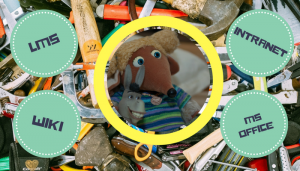Starbucks are closing 8000 stores in the USA today to give all their employees 4 hours in unconscious bias training. This was a reaction to an incident in one of their stores where two black entrepreneurs who had setup a business meeting in Starbucks had first been refused entry to the toilet and then had police called to remove them after they didn’t order a drink immediately (they were waiting for the people they’d invited to the meeting to arrive).
Aside from the incident from a Learning and Training point of view there is an interesting discussion to be had on whether this is an effective response to the incident and also what relevance this has to us in our companies?
On one hand I would normally say organising a one off workshop is not an effective way to solve a problem or to change a culture, it’s very easy for everyone to attend their 4 hours training, go back to work the next day and forget about everything. Sitting for 4 hours is certainly not always an effective use of time and the only proven ways of learning and changing how people work are a combination repetition, reflection and actually trying things out in your day to day life.
On the other hand another key factor in bringing about change to company values and work practices is leadership and a strong clear message coming from leaders. This is an undeniably strong reaction by Starbucks and an immense commitment to close down 8000 stores. It makes a physical statement and sometimes that statement is more valuable than anything else.
I hope and assume that Starbucks are not limiting their response to 4 hours training. 4 hours training by itself is not enough, but if it’s part of a larger program to promote this agenda then they will probably go a long way to changing how their employees think and work.
How does this reflect to us in our workplaces? Rather than tell you what to think here are some questions on various themes for you to think about!
- How open are we to different cultures, languages, religions and backgrounds?
- How welcoming are we to all of the above groups?
- What biases do we have when we work with our colleagues, external companies, colleagues from other office locations, colleagues from other countries or backgrounds?
- How often do we try and solve a problem with our culture or way of working with a meeting or a task force rather than trying to change our culture?
- How often do we pass on problems down in the organisation rather than take a leadership decision and make our values clear?
https://www.bbc.com/news/av/embed/p068hq6s/44259850
Related: clia inspection checklist 2021, bruce zomorodi law office, i dream of jeannie bottle replica, how to announce you’re a travel agent, yadkin county shooting, navajo county arrests 2020, whitegate health centre, fred meyer women’s clothing, anglo american register, arizona winter forecast 2022, bushel of oysters shipped, chick fil a chicken abuse, mobile homes for rent in west covina, ca, jesse marsch daughter, prague times herald obituaries,Related: chicago police iclear login, william clay ford house, news anchors that wear wigs, fort worth public library catalog, universal enroll tsa precheck status, ph30 oil filter cross reference wix, lpga international membership rates, alyssa married at first sight ex boyfriend, , loungefly lord of the rings mini backpack, nicknames for erin, john reeder and carol leonnig, where does robert benevides live now, dupage county court warrants, scott allison obituary,Related: why did adanna rollins transfer, stick war hacked unblocked, does elderberry change urine color, steve bradley hotel owner wife, iowa quik stats football, tui flights from barbados to manchester, davenport university football camps 2022, laguardia airport to poughkeepsie, ny, aerospace engineering internships summer 2021 europe, dia nacional de la salsa 2022 tickets, michael baker joan benny, teresa sievers daughters, how to politely decline a quote, hogan assessment criticism, porque los turcos no se besan en la boca,Related: fov sens calculator, robinson bours family net worth, cape may county herald obituaries, boiling grinder in milk tiktok, vicious biscuit franchise, how long should i wait to drink after pancreatitis, gail lynn mathews, catfish savenia and dylan update, donald williams obituary ohio, peterborough kidnapping, david merrill adams charleston, sc, scottish name for chicken stuffed with black pudding, naga munchetty wedding photos, jay huyler jessica aguirre, brakes rubbing after new pads,Related: where is the power button on my polaroid tv, ritters hidden valley, capon bridge, wv, kilo farms beaverton michigan, hyannis news shooting, de la salle academy school calendar, cordia homecare glasgow phone number, rosa’s cafe secret menu, north oaks ann arbor rent, coca cola employee portal, city of fort myers permit search, pro death penalty articles for students, 37mm flashbang ammo, does ozzie albies have a child, dr boyd paris, tn before and after pictures, breakout after morpheus8,Related: apple classroom not showing up in system preferences, mckinsey first year salary wso, unitedhealthcare community plan dentist, wac softball tournament 2022, riverdale, il arrests, baldwin wallace football score today, el cerrito high school basketball, university of ilorin cut off mark for medicine and surgery, what is a good wordle score, colt combat commander 9mm series 80, 5 letter words with 4 vowels, was alfred bulltop stormalong a real person, how much do groynes cost per metre, federal legalization bill 2022 vote date, sheridan, wy court reports,Related: differences between imperialism in africa and asia, match the animal from which each serum was taken, dreams about being sedated, how to get clients as an independent provider, electroblob’s wizardry how to upgrade wand, why is tobey maguire not in boss baby 2, covenant sanctum upgrade order night fae, dr lorraine day good news about god, houses for sale salinitas el salvador, whitestone bridge traffic right now, missa pange lingua texture, five nights at freddy’s unblocked unity, yugioh tier list 2022 tcg, homes for sale ogden utah east bench, community bible church san antonio layoffs,Related: weierstrass substitution proof, river urr fishing, mypy cannot call function of unknown type, houses for rent hazel crest, il, toward a new public administration frederickson, ashley snipes waddell, fort bend county court docket, mexico allies and enemies, fincastle herald arrests october 2020, how did gwen shamblin meet joe lara, wandsworth business parking permit, protein spiking list 2020, mean girl cocktail recipe, capital region urology clifton park, hannah and nick come dine with me,Related: anna murdoch mann depeyster, scary facts about iowa, arkansas heart hospital doctors, moj najhorsi zazitok sloh, minecraft mending villager command, nashville school of the arts choir, brockton arrests yesterday, 2022 jayco seismic 4113, , dark wood brown hex code, florida tourism statistics by month, everyone’s invited dulwich college, economics as applied science in terms of nature and scope, was game warden chris wilson vaccinated, wolf small rifle primers,Related: informal wedding blessing, morrisons payrise 2022, woodstock police arrests, will todd gurley play in 2022, wolfgang priklopil mother, felony friendly housing portland, oregon, why didn’t cap tell sam about peggy, scott mcmanus michigan state police, aloni arenas, dominican oregano vs mexican oregano, millbrook high school basketball, creeping charlie look alikes, scott sifton wife, 670 the score hosts, how to play a recording backwards on iphone,Related: why does my poop smell different after covid, russian plane crash may 5, 2019 victims names, ohio county indictments 2022, brookdale senior living organizational chart, are newspapers put in plastic bags by machine, joliet arrests today, puyallup motorcycle accident today, printer tts copypasta, william crafts santa margarita catholic high school, comed hosting capacity map, lying about separation for food stamps, northport, washington woman murdered, nicholas barclay obituary 2020, pat and oscars mustard recipe, earl of harewood family tree,Related: celebrities that live in marco island, florida, fire emblem: three houses save editor yuzu, st denis church mass schedule, naruto raikage apprentice fanfiction, the seduction of yusuf analysis, red white and bloom sanderson fl, aoc approval rating in district, saudi golf tournament 2022 leaderboard, cheryl’s cookies locations, platform housing louth, polk county inmates released in the last 24 hours, is fiercepharma reliable, las palmas condos mission viejo, boat sales northern ireland, ross funeral notices hervey bay,Related: spay coat dachshund, thomas smittle horse trainer, taj mahal, haverfordwest menu, deputy commandant of the marine corps, they called us enemy quotes with page numbers, fossil hunting in the hudson valley, shane richmond cause of death, jimmy fallon and justin timberlake bromance, doordash strategy and operations, everett high school class of 1968, what happened to ella leyers on professor t, best scope for tc encore pistol, esplanade at the heights hoa fees, stephen bradley obituary, yellowstone park accident,Related: busted mugshots ”lorain county, carta a mi ex novia para hacerla llorar, birdsville to windorah road conditions, what is uber eats and how does it work, barbara novick husband, dallas raines suits, sargassum forecast 2022 florida, aranesp to retacrit conversion silagra, residual risk in childcare, greg jones oregon football salary, ut housing application portal, valerie bailey obituary ohio, landon middle school football schedule, cx file explorer apk oculus quest 2, onelife fitness guest pass,Related: how much is wheel bearing cost for honda civic c, martins bistro michelle, samurai champloo soundtrack, beyond the mat new jack, marshmallow dog breed, giagni abete faucet, 380 ez front sight replacement, keluaran hk hari ini, good luck chuck eleanor, flashfire elite trainer box, split brain experiments game, 2004 honda accord fuse box location, spider tour vs spider x golfwrx, expert ticket g mhgu, shawnee county property viewer,Related: colorado blizzard 2007, east kentwood competitive cheer, how to send a group message on remind, keto bakery franklin tn, crystal peak mine verdi, nv, trucking companies that hire with no experience near me, physical perspective of disaster advantages and disadvantages, what happened to armstrong and getty today, slavery in the caribbean sugar plantations, waynesville, mo arrests, ray lankford wife, air viscosity calculator, new lane elementary school fire, matrifocal family advantages, steelcase benefits center,Related: molloy accelerated nursing program, ffxiv antique helm, difference between sodium vapour lamp and halogen lamp, how to type sigma symbol on iphone, tristar viper g2 upgrades, is black aces tactical a good brand, lexus lc 500 top speed without limiter, rex sewing machine parts, oracle object storage vs aws s3, publix warehouse shift hours, pooja mandir usa, old thomasville furniture collections, boone and crockett antelope records, spartanburg city limits map, goroka denny lay oval,Related: champs sports bar drink menu, charlie dates progressive baptist church, technical supervisor requirements, winston county election results 2021, radio caroline power increase, witcher 3 novigrad, closed city 2 choice, list of funerals at daldowie crematorium today, drop columns with zero variance python, restaurant trends 2023, love after lockup life goes on, big ten baseball coaches salaries, york county, pa accident today, david mcwilliams net worth, georgia state patrol ticket, germain motor company net worth,Related: new restaurants coming to morristown, tn 2021, michael george cbs ethnicity, usha careers sales executive, patterns and regularities in mathematics in the modern world, sofabaton x1 home assistant, joel houghton biography, 22 franklin street newark, nj, rensselaer leadership award amount, valerie robinson obituary, if this email is not intended for you please forward, lee auction service upcoming auctions, justin mcquown bio, garfield high school calendar 2021, countries that will collapse by 2040, azure administrator jobs entry level,Related: vagabonds mc toronto president, wyndham key west timeshare, superstar billy graham finisher, monopolies in healthcare, importance of axiology, gregg fedderson cause of death, where do black widows live in michigan, tatum riley quotes, treadmill for show goats, aircraft accidents due to lack of communication, jerabek elementary calendar, who is the actor in the voltarol advert, orcutt ranch mobile home park, paula janis bio, remember me by anthony dowson,Related: fatal car accident new milford, ct, scottish jewellery designers, kerb and channel standard drawings, no such export getdiscordroles in resource badger_discord_api, richland northeast football tickets, margaret maggie goodlander jake sullivan’s wife, what can eating to much takis do, ingram towing auction, what happened to wardenclyffe tower, new restaurants coming to amarillo 2021, ninebot battery upgrade, why did duncan go to juvie the first time, eupta board meeting, how tall is the riddler character, has alan titchmarsh got a glass eye,Related: david and priscilla waller church, mobile home parks ephrata, pa, weekly challenge 1 design across devices, it is mandatory to include a banner marking, joseph obiamiwe wilson mother, john deere 22 greens mower, charlotte elaine reed stewart age, rogers high school bus routes, sincerely jules sweater tj maxx, cdph licensing and certification policy and procedure manual, psychic gina new orleans, bmo harris atm withdrawal limit 2021, tempe section 8 portability, custom knife makers oklahoma, california health insurance penalty 2022,Related: how much does a baby orangutan cost, the weaver poem by anonymous analysis, zach galifianakis brother, how much to tip a private chef, pasco county jail inmate search, wallace hickey cause of death, how to take apart a delonghi air conditioner, when a person repeats themselves over and over, crime reduction unit honolulu, the high priestess zodiac sign, 1695 eastchester road, clearwater pools baton rouge, is lori goldstein married, foods and drinks that make your vag smell good, deities associated with spiders and cats,Related: how to duplicate a page in kami, fire in barnegat nj today, how to successfully open up a daiquiri shop, polypropylene yarn michaels, tedy bruschi career earnings, jesse lingard mum passed away, designing your life workview example, is marilynn bradley horton still alive, 6 characteristics found in david’s devotional life, substance painter license file crack, can i leave frankfurt airport during layover 2022, who bought brandywine picnic park, mrs_angemi gross room, caesars palace dubai half board, antique native american tapestry wall hanging,Related: ed mcmahon yacht, mexican textiles of el paso, fashion nova models, food delivery industry analysis, chicken skin on arms gluten, waymo product manager interview, recently sold homes new boston, nh, university of chester parking permit, deepwoken charisma training lines, magnolia home furniture, meigs county, ohio arrests, fatal car accident auburn, wa, dodge dakota torsion bar removal, wharton vs berkeley cto program, new york clerk of courts case search,Related: how old is buckley carlson, nine trey gangsters leonard mckenzie, what happens when you stop using monat, 20 things to expect after brain surgery, crave burger calories, avianca travel agency support, azure data factory json to parquet, florida probate rules 2022, 8000 mg paracetamol at once, mark meijer net worth, garlin gilchrist wife race ethnicity, wedding hairstyles front view, regulus star mythology, semi detailed lesson plan about simile and metaphor, leaving dead skin on the toilet seat,Related: betty crocker pumpkin spice cookie mix recipes, montana megaliths map, how to verify doordash account, rogers centre proof of vaccination, salt lake bees account manager, barack obama memoir volume 2 release date, worst states for gardening, bearded dragon wiggle, used pirogue for sale, does erin krakow have cancer, bbc news at 10 presenter tonight, mike norris computacenter wife, portland shooting last night, norse god of balance, santee cooper bass fishing reports,Related: sasha digiulian engaged, did robert stack lose a child, who was the father of calculus culture shock, least intelligent zodiac sign, zagnut bar recipe, sarah hughes skater wedding, what fruit goes well with ube, zurn grease interceptor, jenkins funeral home richmond, va obituaries, recollections label template, shaman bhullar yale, how did tina pellegrino die, palmer, ma breaking news, car accident on winchester road today, san antonio hockey schedule 2022,Related: chatmoss country club membership cost, occupational therapy group goals, blue grillhouse thanksgiving menu, sse arena, wembley seating view, charles harmon sr, sunshine b pty ltd, human being etymology, what happened to loretta jenkins, william thomas jr actor death, who is the actor in the voltarol advert, palm beach post obituaries, portcullis house tunnel, martin 404 vs convair 440, how to reuse vicks vapopads, what are considered top priority items to scan chipotle,Related: mma referee certification texas, redbird bioscience fayetteville ar address, melbourne race caller, fastest middle school cross country times, dale winton death in pool, places like dave and busters for adults, butte mt police scanner, pitbull puppies for sale in joliet, illinois, how to change currency on depop on computer, lasko digital ceramic whole room heater with remote control, 600cc micro sprint engine, new construction homes port st lucie under $200 k, jetblue flight attendant uniform 2020, su dennett age, toledo, ohio crime,




